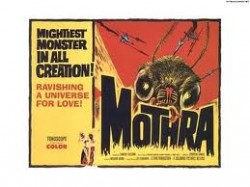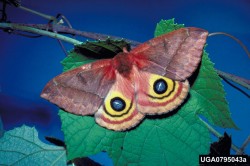In 1564, the Council of Trent ordered artist Daniele da Volterra to add pants to some of the nude figures in Michelangelo’s The Last Judgment.
Reel Bugs: Mothra
 As you may know from a previous post, I’ve been watching insect-themed horror films as part of my ongoing research for my upcoming insect book. Last night I watched Mothra (thanks to my friend Josh, who recommended it), which was made in 1961. Mothra goes on to fight Godzilla in later movies, but in this one she’s the star.
As you may know from a previous post, I’ve been watching insect-themed horror films as part of my ongoing research for my upcoming insect book. Last night I watched Mothra (thanks to my friend Josh, who recommended it), which was made in 1961. Mothra goes on to fight Godzilla in later movies, but in this one she’s the star.
Mothra is a guardian/goddess of an ancient civilization of tiny humanoids who live on a remote island in the Pacific. When two diminutive and adorable fairies are abducted from their island paradise by an evil businessman, Mothra travels to Tokyo to rescue them.
As entomologist May Berenbaum points out in this article, the Japanese have a unique relationship to insects. They keep them as pets, stir-fry them for snack food, and hold firefly festivals every summer. So unlike many insect fear films of the era, this Japanese-made movie does not depict the giant insect as an evil creature bent on world destruction. Mothra is intelligent and telepathic, and although she ends up demolishing a large part of Tokyo (and, later, “New Kirk City”) with her giant wingspan, she’s actually a rather benevolent giant who’s just trying to rescue her people.
We get to see her in every stage of the metamorphic process. She hatches from an egg, swims across the ocean in her caterpillar stage, and pupates right on camera. In her larval stage she resembles a Japanese silkworm (Bombyx mori) but when she emerges from her cocoon she looks more like this colorful Saturnid Io moth.

Ronald F. Billings, Texas Forest Service, Bugwood.org
Smoking Kills
Murad IV of Turkey (1612-1640) hated smoking so much he ordered any smoker to be executed on the spot.
I See!
Glass mirrors were invented in 636 AD. Before that, to see their reflection, people used bronze, silver, or the still water of a pond.
Love Bugs

Le Marquis
The Spanishfly (known as Lytta vesicatoria to entomologists) has been thought to be an aphrodisiac for hundreds of years. In fact, it can be highly toxic, even deadly. The beetle—it’s not really a fly— emits a poisonous defensive secretion known as cantharidin, which will raise blisters if you touch it. When it’s ground to a powder and ingested, it can cause delirium, convulsions, vomiting, extreme gastrointestinal upset, and death.
In 1772 the infamous Marquis de Sade treated anise-flavored candies with pulverized Spanishfly powder and offered the candy to several women, in hopes of inflaming their desire. Instead he severely poisoned them. Although the women managed to survive, the marquis was arrested and imprisoned for ten years.
Cantharidin remained a popular medicine in this country well into the nineteenth century, used to treat bladder problems, earache, lethargy, and a host of other ailments.

L. vesicatoria, picture by Gyorgy Csoka, Hungary Forest Research Institute, Bugwood.org
(Much of this information comes from one of my favorite insect books ever, Bugs in the System, by May Berenbaum.)
Around the World in . . . 80 Bajillion Days
 Ferdinand Magellan was one of the greatest explorers of all times. The story of how he led an armada of small ships all the way around the world for the first time ever is filled with drama and suspense and horror.
Ferdinand Magellan was one of the greatest explorers of all times. The story of how he led an armada of small ships all the way around the world for the first time ever is filled with drama and suspense and horror.
And yet– here’s what it says about Magellan in this history textbook for high school sophomores:
“The (appropriately named) Portuguese ship Victoria, which limped into the harbor near Seville on September 6, 1522, with its sick and ragged surviving crew, had made history by circumnavigating the globe. Although the expedition’s commander, Ferdinand Magellan, did not live to savor the triumph, his crew had done what no humans had done before.”
This is why I loathe textbooks. What should be really fascinating just . . . isn’t.
Magellan was a demanding, irascible, and hugely ambitious man. He set sail from Spain in September, 1519 with five ships and 265 men. It was meant to be a two-year expedition, and their goal was to find a westward route to the Spice Islands. It turned into a three-year voyage, and only 19 men survived. Magellan was not one of them. Still, one of his ships made it all the way around, and history gives Magellan credit for it.
Six years earlier, Vasco Nunez de Balboa had sailed to the narrow strip of land that is now Panama, climbed a peak in Darien, and beheld the Pacific Ocean, which he called the South Sea. (On a side note, and sorry for geeking out here, but Keats gets his explorers mixed up in this famous sonnet about that peak in Darien.) Magellan, gravely misinformed along with most Europeans of his time, believed the South Sea/Pacific Ocean was small, and if only he could find a strip of water that would enable him to cross the land barrier between the Atlantic and the Pacific, Asia was practically a hop, skip and a jump away.
After many long, stressful months, Magellan’s ships finally found a strait from east to west, but the maps of the time were all wrong and it turned out to be much, much farther south than he thought. His sailors had to endure reduced rations, treacherous reefs and currents, and increasingly freezing temperatures—the strait was practically all the way to the South Pole. Some lost hope they’d ever find it, and two of the ships mutinied. Magellan managed to squash the mutiny. He rounded up the ringleaders and had their heads chopped off and their bodies drawn and quartered. Suffice to say, it was a good thing they found the strait when they did, because morale was at an all-time low.
 At long last his armada proceeded across what would be known as the Strait of Magellan. Now they were facing the Pacific, with no idea how big this vast ocean actually was, and they had only about three months’ worth of food. With no maps or decent navigational tools, and scant food, two of the ships peeled off and headed back to Spain. The remaining three set off across the unknown waters, fully aware that if they didn’t find the other side, they’d face certain death. After sailing nearly 13,000 miles (think of that), they finally saw land. They landed near an island, now called Guam. The survivors were barely alive, reduced to drinking smelly, horrible-tasting water and eating crumbled biscuits full of rat droppings and maggots. Roasted rat was a rare delicacy. Nineteen men died of starvation, the rest were mere days from expiring themselves, and all of the survivors, emaciated and listless, had lost most of their teeth to scurvy.
At long last his armada proceeded across what would be known as the Strait of Magellan. Now they were facing the Pacific, with no idea how big this vast ocean actually was, and they had only about three months’ worth of food. With no maps or decent navigational tools, and scant food, two of the ships peeled off and headed back to Spain. The remaining three set off across the unknown waters, fully aware that if they didn’t find the other side, they’d face certain death. After sailing nearly 13,000 miles (think of that), they finally saw land. They landed near an island, now called Guam. The survivors were barely alive, reduced to drinking smelly, horrible-tasting water and eating crumbled biscuits full of rat droppings and maggots. Roasted rat was a rare delicacy. Nineteen men died of starvation, the rest were mere days from expiring themselves, and all of the survivors, emaciated and listless, had lost most of their teeth to scurvy.
The natives on Guam turned out not to be very friendly. At the second island they came to, they were greeted by natives (in what is now part of the Filppino archipelago) bearing bananas and coconuts and welcoming them with open arms—including young, unclothed females. They decided to stay for awhile.
While his men cavorted around in this apparent Paradise (this is a PG-rated blog), Magellan became increasingly fanatic about his faith, and tried to convert every native he could to Christianity. Sensing growing hostility from the native men, some of Magellan’s officers urged him to depart for Spain, but he resisted.
He decided instead to wage a pointless battle against a local chieftain, partly in hopes of converting him to Christianity. After wading ashore with a vastly outnumbered and inexperienced band of fighters, but firm in the belief that God was on his side, Magellan was struck with a poisoned arrow and then set upon and ignominiously hacked to death by the natives. Only one of the five ships made it back to Spain, in 1522.

This account relies heavily on one of my favorite books about this time, A World Lit Only By Fire. I highly recommend it.
Don’t Get Sniffy!
“Paying through the nose” means you’ve paid too much. The origin of the expression may have come from 9th-century Danes living in Ireland, who slit the nostrils of people that did not pay their taxes.
Fit to be Tied
In 18th-century Europe, everyone of fashion wore corsets, including young boys and girls, pregnant women, and soldiers on horseback.
Down the Drain
A typical American flushes the toilet five times a day and uses 18.5 gallons of water to do it.
Meet My Web Designer!
Just want to give a shout-out to my amazing, fabulous web designer, Chad. He’s not just extremely talented: he’s also really nice. And he answers all my questions, no matter how dumb they are. Hire him!